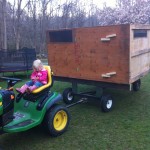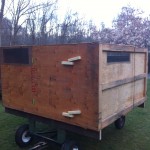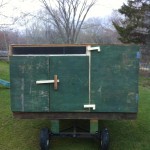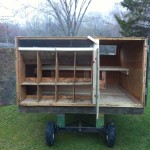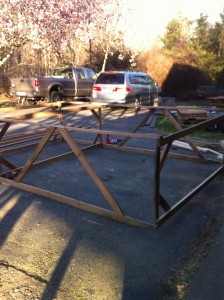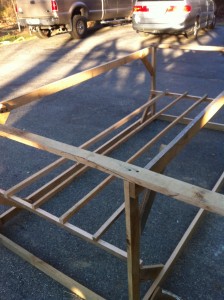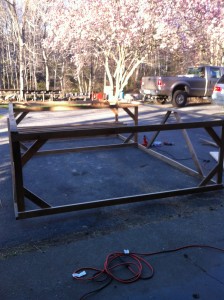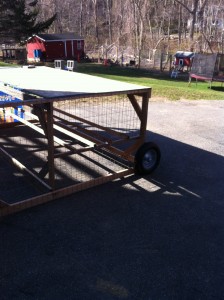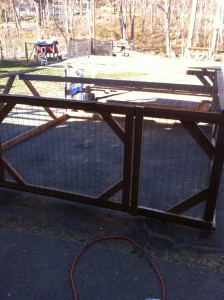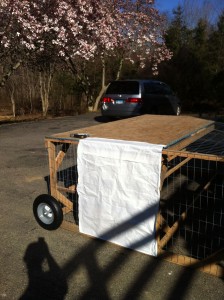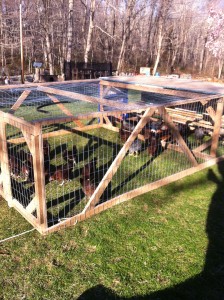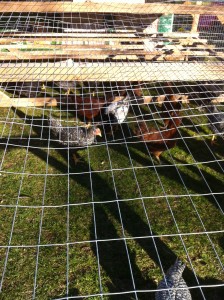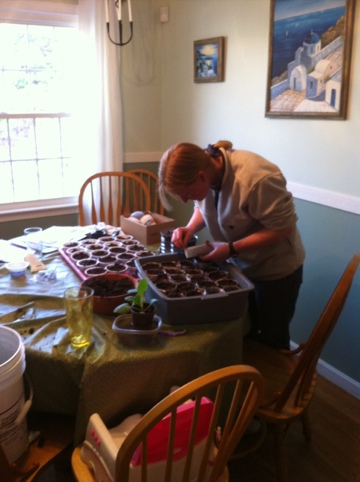Tonight, we re-watched Food, Inc. If you haven’t seen it, you should watch it. It is enlightening about life in general. For us, it reinforces our choices about how we raise food and what we choose to eat.
All dressed up
Mobile chicken coop
I have completed another chicken coop for the farm. I used a farm wagon (purchased used for $100) under a shipping crate (free) for the coop. The shipping crate was laid on its side, making a 7’x7′ coop that is 44″ high. The 8 nest boxes inside were free from someone else no longer keeping chickens. I put ventilation on 3 sides and both a front and rear access door to make cleaning easier. Once it warms up, we will get some more oops paint at Home Depot and paint the coop a natural color to blend in to the scenery.
Total cost on this coop was a little higher because of the wagon. I spent about $125 with the wagon, hardware ,and lumber used. We plan to house up to about 25 chickens in this coop with electric netting around it. Once the netting arrives, we will move the Jersey Giants into the coop (even though there are only 6 birds) and put it near the back of the farm.
Easter Sunday morning
Meat chicken reservations filling up fast
If you are considering preordering meat chickens with us, make your reservation soon. We are taking deposits for the first batch of 50 Freedom Ranger broilers. After we subtract the ones for ourselves, only 14 birds have not yet been reserved. The first batch will be harvested approximately July 7/8. Email us if you want a reservation.
Chicken Tractor, Sawyer style
For those of you not into the grow your own meat movement, a chicken tractor is a moveable chicken pen. It is intended to be moved daily to allow the chickens access to grass and bugs while providing shelter at night and protection from predators. We needed a chicken tractor to house chickens as they grow to be replacement hens, roosters for meat, and our upcoming order of broilers. For now, we have only built 1 tractor to decide what we do and don’t like about it. There are many common designs, and probably the most notable is Joel Salatin’s design.
Our chicken tractor is made entirely out of red oak. Now you might be wondering why I would make a chicken pen out of red oak, and it’s a very simple answer: mahogany would have been ridiculous and maple shows the dirt too much. Seriously, I just had a lot of extra red oak on hand and it made more sense to use excess wood I have than to spend money on new pine. I also had 6′ 2″x4″ field fencing, so that is what I used for the sides. I built the tractor 8′ wide and 12′ long. I specifically chose 8′ (instead of the common 10′) because if we move or I decide to sell this version, it is still small enough to be transported on a flatbed trailer.
What makes this Sawyer Style, it the recycling. The total cash expended on this project was $25 for the 2 wheels and 2 door hinges. Everything else was stuff we already had here on the farm with no predetermined purpose. Sure, at some point I bought the red oak, but it was almost firewood, so I might as well use it in a project.
We did put a roof made of OSB to give the birds shelter. The sides under the roof will be finished in using feed bags to provide wind shelter. We will still add a waterer and feeder that can be accessed from outside the fencing. We also put roosts into the back of the tractor in the sheltered area in order to give the birds somewhere to get off the ground. Hopefully, that will keep them healthier and minimize the chance of a predator pulling them out from under the edge.
A few immediate observations of what we don’t really like.
1. The only access is from the 4′ wide door in the front. You have to get down on the ground to get inside. I think that will get old in bad weather.
2. The extra support frame at the divider between the shelter and open areas is a death trap for the chickens. When pulling the tractor on the ground, the birds tend to stay towards the middle. Unfortunately, that cross-bar is in a perfect spot to trap chicken legs and cause injuries. I may have to cut it out.
3. Red oak makes a heavy tractor. I did include wheels on the back, but it’s heavy. On the positive side, it is definitely sturdy.
Here are some pictures. The tractor was put to use this afternoon with 38 birds we are raising that are 8-9.5 weeks old. If you are thinking about building your own, come on over and take a look.
Alex is a speed reader
Last weekend, Anna got the first Harry Potter book at the library for Alex. He started reading Friday afternoon and finished Saturday night. This week, she got the second book, and again, he read it Friday evening through Saturday night. He even spent some time reading out loud to his sisters.
We believe in the 2nd Amendment and firearm education
Getting some broilers
Anna and I have debated many times the advantages and disadvantages of what to raise for a meat chicken. In the end, our primary concern is that we are raising a healthy chicken for our family to eat. We are offering some extra birds for sale, but based on the time committment to process the chickens (and raise them) we do not anticipate raising hundreds of chickens at a time. So, despite some previous discussions and plans, we have decided to order Freedom Rangers. One significant advantage of this bird is we can keep some for our own breeding stock if we want. The first batch of chickens will get processed in late June or early July.


